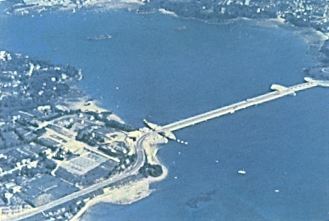Tidal Power The tides go 'in and out' as they are pulled by the moon's gravitational field, and we can capture energy from this massive movement of water (kinetic energy of the water) with tidal power stations.
Tidal power stations are built to stretch over places that are affected by the tides - such as deltas or estuaries. A barrage is set across a beach or river. When high tide comes in, water flows through a turbine to create electricity. The water level in the river mouth is now high so a gate is lowered , trapping the water behind it and preventing it from just going out with the tide. When low tide comes, the gate is raised and the water flows out, transferring its energy through turbines. This way, electricity is created with a two-way turbine. HistoryTidal mills were invented in the early 1900s. They didn't have two-way turbines then - they only used one tidal direction. They chose to capture the tides as they were receding, because there was the most possible outcome from there. When the tide came in, the floodgate lowered, trapping the water above it. When low tide came, the gate was lifted up, and the water turned a water wheel. The wheel could then power the mill. Advantages
Disadvantages
|
Follow me...
|






